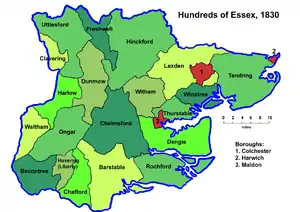
Between Anglo-Saxon times and the nineteenth century the English county of Essex was divided for administrative purposes into 19 hundreds, plus the Liberty of Havering-atte-Bower and the boroughs of Colchester, Harwich, and Maldon. Each hundred had a separate council that met each month to rule on local judicial and taxation matters.
Essex probably originated as a shire in the time of Æthelstan.[1] The Domesday Survey listed nineteen hundreds, corresponding very closely in extent and in name with those that were in use until early in the twentieth century.[1][2] The additional half-hundred of Thunreslan on the border with Suffolk no longer exists,[1] and the hundred of Witbrictesherna was renamed Dengie. The liberty of Havering-atte-Bower was formed from land taken from Becontree hundred.[1][3] In the time of Edward I, Clavering and Freshwell were each considered half-hundreds in Essex.[4]
Parishes
At the start of the 19th century, the hundreds contained the following parishes:[5]
References
- 1 2 3 4 Chisholm, Hugh, ed. (1911). . Encyclopædia Britannica. Vol. 9 (11th ed.). Cambridge University Press. pp. 783–786.
- ↑ Open Domesday: Essex. Accessed 10 June 2023.
- ↑ "The hundred of Becontree: Introduction". A History of the County of Essex: Volume 5. 1966.
- ↑ The National Archives: Description of the Essex hundreds and half-hundreds. Accessed 10 June 2023.
- ↑ "Essex". A History of the County of Essex.
- ↑ John Bartholomew (1887). Gazetteer of the British Isles.